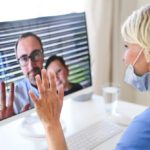The Multiple Ways Telehealth Is Provided, and Where You Fit In
Telehealth jobs provide an entire network of expertise that provides American patients with exceptional and accessible care. Where do you fit in?
One thing is for sure: telehealth is here for the long term. You’re in demand. There are plenty of reasons a switch to a career in telehealth could be just what you need. With several areas to best place your skills and expertise in telehealth jobs, let’s look at the different ways telehealth is paving a new future in healthcare.
Live Video Conferencing
Live video conferencing has become increasingly popular in the healthcare industry. It allows for doctors to see patients without having to travel long distances, which saves time and money for both parties. This technology can also be used by hospitals to connect patients with remote specialists who are not available on site.
Through live video conferencing, patients can connect with healthcare specialists in real time and receive advice, diagnosis, treatment plans and prescriptions as if they were in the same room. This also allows medical professionals to consult with one another far more easily than they would be able to by phone or email.
Asynchronous Video
Asynchronous communication in telehealth is a store-and-forward communication that can be accomplished through video, text, or audio. Data is stored until it is retrieved by the remote clinician and sent to the patient’s device.
There are many benefits to asynchronous communication in telehealth for medical professionals. One of these is that it can reduce costs associated with travel. Another is that it reduces wait times for appointments.
Remote Patient Monitoring
Remote patient monitoring systems allow healthcare providers to provide patients with the treatment and support they need without having to be physically present. It is commonly used to make sure patients are complying with their treatment instructions, and it is also great for quickly identifying any worsening health conditions.
There are two types of remote patient monitoring: proactive and reactive. Proactive remote patient monitors provide ongoing surveillance such as regular phone calls or emails. This gives the provider an opportunity for early intervention before a problem becomes severe or chronic. Reactive monitors are used when a health concern arises, such as an asthma attack.
Mobile Health
Today there are many apps in the palm of patients’ hands that encourage patients to increase their education in their own health. Such apps can monitor everything from daily water intake to a diabetic’s sugar levels – with the support of telehealth professionals to hand.
Medical Imaging
With technology allowing X-rays, scans, and other images to be assessed by relevant specialists at speed, patients benefit from faster diagnoses. If you’re a licensed radiologist, or a cardiologist, for example, you’ll be sent images to assess, diagnose, and respond back with analysis within a matter of hours or days as opposed to weeks.
Find Your Telehealth Jobs Here
In telehealth, there are plentiful benefits and career paths available to you as a healthcare professional. To find your perfect telehealth job today, search the Telehealth Gigs jobs board and start an incredible, stable, and rewarding new career path now.







